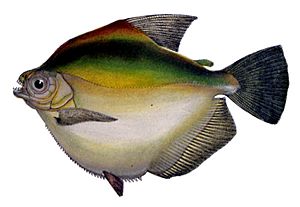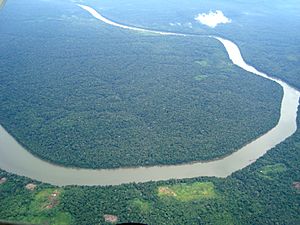Silver mylossoma facts for kids
Quick facts for kids Mylossoma duriventre |
|
|---|---|
 |
|
| Painting by Castelnau, 1856 | |
 |
|
| X-ray image | |
| Scientific classification |
The silver mylossoma (scientific name: Mylossoma duriventre) is a type of freshwater fish. It belongs to a group of fish called serrasalmids. This fish is found only in certain parts of tropical and subtropical South America.
Silver mylossomas can grow up to about 25 centimeters (10 inches) long. They can also weigh around 1 kilogram (2.2 pounds). People in South America often catch them for food. In Brazil, they are called 'pacu', and in Venezuela, they are known as 'palometa'. These names are also used for other fish that are related to them.
Contents
Where Silver Mylossomas Live
The silver mylossoma lives in freshwater systems. For a long time, scientists thought this fish lived in many large river basins. These included the Amazon, Orinoco, and Río de la Plata basins. It was also thought to live in the Tocantins River and its branch, the Araguaia River. This fish likes water that has a lot of nutrients. However, it can also be found in the lower parts of rivers with fewer nutrients.
In 2018, scientists looked closely at the fish's DNA and body shapes. They found that Mylossoma duriventre actually lives in a smaller area. Its home is mainly the Río de la Plata Basin. This includes the Paraguay, lower Paraná, and Uruguay rivers.
Scientists also found that two other fish, once thought to be the same as M. duriventre, are actually different species. These are M. albiscopum from the Amazon and Orinoco basins. The other is M. unimaculatum from the Tocantins–Araguaia basin.
How Silver Mylossomas Live
This fish is known for its special migration. It moves entirely within freshwater, never going into the ocean. Scientists are still learning about their exact travel patterns.
During the rainy season in the Amazon, from December to March, the fish move. They travel from lakes and pools on the floodplain to bigger rivers. They swim upstream in large groups to places where they will lay their eggs. However, the exact spots where they lay eggs are not fully known.
After laying eggs, the adult fish move out of the rivers. They swim into the forest floor when it becomes flooded. At the same time, the tiny baby fish (larvae) are carried downstream by the water. When the forest floods, these larvae spread out into special nursery areas on the floodplain. Here, they can easily find the tiny plankton they eat.
When the floodwaters go down, both adult and young fish move back into the rivers. They then swim upstream to the floodplain lakes. In the várzea forest, which floods every year, the silver mylossoma often lives close to another fish called Potamorhina altamazonica.
Young silver mylossomas eat insects. Adult fish, however, prefer to eat fruits and seeds.
Dangers to Silver Mylossomas
In some areas where it lives, the silver mylossoma is considered a vulnerable species. This means it is at risk of disappearing. Many things threaten these fish.
Some of the main threats include:
- Farming: Farms are taking over the forest areas where the fish live.
- Mining: Mining activities can pollute the water and destroy habitats.
- Dams: Large dams built for hydroelectric power can block their migration paths.
- Overfishing: Too many fish are being caught, which reduces their numbers.
- Tourism: Activities by tourists can disturb their natural homes.
The yearly flooding of the forest is very important for the survival of the young fish. If these floods change or stop, it could harm the silver mylossoma population.
See also
 In Spanish: Pacú-peva o pacú reloj para niños
In Spanish: Pacú-peva o pacú reloj para niños


